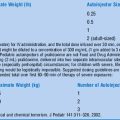Chapter 7 Apnea
4 What are some of the pathophysiologic factors contributing to apnea in young infants?
 Hypoxic drive: In the neonate, hypoxia results in a brief increase in respiratory rate followed by depressed respiratory drive and apnea. Mild hypoxemia during sleep can cause periodic breathing or apnea, and hypoxemia during sleep may not cause arousal.
Hypoxic drive: In the neonate, hypoxia results in a brief increase in respiratory rate followed by depressed respiratory drive and apnea. Mild hypoxemia during sleep can cause periodic breathing or apnea, and hypoxemia during sleep may not cause arousal.
 Effects of feeding: Difficulty with coordination of sucking and breathing can result in hypoxemia. The presence of an accentuated laryngeal chemoreflex can cause apnea and bradycardia if regurgitation occurs while the infant is hypoxic.
Effects of feeding: Difficulty with coordination of sucking and breathing can result in hypoxemia. The presence of an accentuated laryngeal chemoreflex can cause apnea and bradycardia if regurgitation occurs while the infant is hypoxic.
 Metabolic abnormalities: Apnea can develop in newborns and young infants as the result of hypoglycemia or anemia.
Metabolic abnormalities: Apnea can develop in newborns and young infants as the result of hypoglycemia or anemia.
 Mechanical factors: Because of the pliable thoracic cage and fatigability of the diaphragmatic muscle, attempts to increase minute ventilation by increasing tidal volume can increase the work of breathing. Thus, the infant in respiratory distress is more susceptible to respiratory failure and apnea.
Mechanical factors: Because of the pliable thoracic cage and fatigability of the diaphragmatic muscle, attempts to increase minute ventilation by increasing tidal volume can increase the work of breathing. Thus, the infant in respiratory distress is more susceptible to respiratory failure and apnea.
5 What are some of the underlying causes of apnea?
 Central nervous system: Seizure activity, breath-holding
Central nervous system: Seizure activity, breath-holding
 Infection: Meningitis, bronchiolitis (in premature infants or infants with lung or heart disease), sepsis, croup, infant botulism, pertussis
Infection: Meningitis, bronchiolitis (in premature infants or infants with lung or heart disease), sepsis, croup, infant botulism, pertussis
 Gastrointestinal: Gastroesophageal reflux
Gastrointestinal: Gastroesophageal reflux
 Metabolic: Hypoglycemia, inborn errors of metabolism, toxin (ingestion)
Metabolic: Hypoglycemia, inborn errors of metabolism, toxin (ingestion)
 Trauma: Accidental or inflicted head or blunt abdominal injury
Trauma: Accidental or inflicted head or blunt abdominal injury
8 What are the risk factors for SIDS? Are they the same as the risk factors for an apparent life-threatening event?
9 Has the decline in the incidence of SIDS resulted in a similar decrease of apparent life-threatening events?
12 Are there specific details that must be included in the history?
Ask these questions to ensure a thorough history:
 Where did the event take place: in the infant’s crib, in another bed, in a car seat?
Where did the event take place: in the infant’s crib, in another bed, in a car seat?
 How long did the episode last?
How long did the episode last?
 Was the infant awake or asleep?
Was the infant awake or asleep?
 Was there a change in the baby’s color?
Was there a change in the baby’s color?
 Was there a change in tone or posture, or were there abnormal movements?
Was there a change in tone or posture, or were there abnormal movements?
 Did the child require resuscitation, and, if so, how did he respond?
Did the child require resuscitation, and, if so, how did he respond?
13 Are there other questions that should be asked in the history?
 History of present illness: Prior to the event, was the child well? Are there symptoms of other illnesses, specifically changes in behavior, activity, and/or appetite? Does the baby have gastroesophageal reflux? Has there been a recent illness, fever, cough, or cold? Has the infant recently received an immunization?
History of present illness: Prior to the event, was the child well? Are there symptoms of other illnesses, specifically changes in behavior, activity, and/or appetite? Does the baby have gastroesophageal reflux? Has there been a recent illness, fever, cough, or cold? Has the infant recently received an immunization?
 Past medical history: Have there been similar episodes in the past? Were there problems with pregnancy, labor, or delivery? What was the child’s birthweight?
Past medical history: Have there been similar episodes in the past? Were there problems with pregnancy, labor, or delivery? What was the child’s birthweight?
 Family history: Is there any family history of seizures, infant deaths, or serious illnesses in young family members?
Family history: Is there any family history of seizures, infant deaths, or serious illnesses in young family members?
 Social history: Who was watching the child at the time of the episode? Are there medications or other toxins accessible to the child?
Social history: Who was watching the child at the time of the episode? Are there medications or other toxins accessible to the child?
19 Should a home cardiorespiratory monitor be recommended for patients after an apparent life-threatening event?
American Academy of Pediatrics: Policy statement. Apnea, sudden infant death syndrome and home monitoring. Committee on Fetus and Newborn. Pediatrics 111:914–917, 2003. Available at http://aappolicy.aappublications.org/cgi/content/full/pediatrics;111/4/914.





